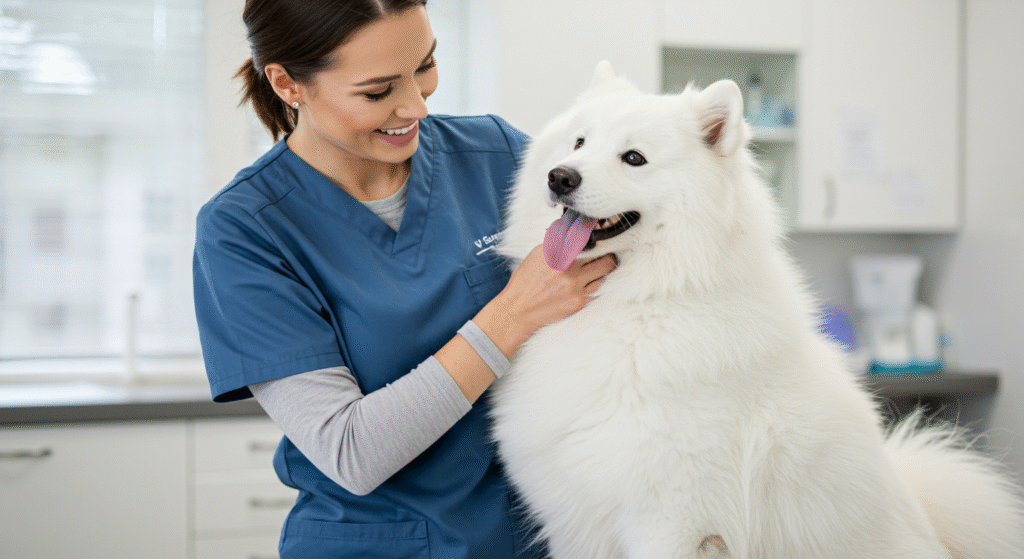Dogs can’t tell us when they feel sick. Unlike humans who can describe their symptoms, our furry companions rely on us to notice the subtle changes that signal health problems. Recognizing the early warning signs of illness in dogs can mean the difference between successful treatment and serious complications.
This guide reveals the ten most critical early signs of illness in dogs, might be developing a health issue. You’ll learn what to watch for, when to worry, and how to respond when your dog’s behavior changes. Whether you’re a new dog owner or have years of experience, these insights could save your pet’s life.
Table of Contents
- Changes in Appetite and Eating Habits
- Unusual Lethargy or Low Energy
- Breathing Difficulties and Respiratory Changes
- Digestive Issues: Vomiting and Diarrhea
- Changes in Urination Patterns
- Behavioral Changes and Mood Shifts
- Physical Signs: Temperature and Body Condition
- Mobility Issues and Pain Indicators
- Coat and Skin Changes
- Eye and Ear Abnormalities
- Understanding Common Dog Diseases
- When to Seek Emergency Care

Changes in Appetite and Eating Habits
Your dog’s appetite serves as a reliable health barometer. Sudden changes in eating patterns often signal underlying health issues before other symptoms appear.
Loss of appetite ranks among the most common early warning signs. Dogs who suddenly refuse their favorite treats or leave food untouched may be developing digestive problems, infections, or pain. This symptom appears in many of the top 10 most common dog diseases, including kidney disease, liver problems, and dental issues.
Increased appetite can be equally concerning. Dogs who suddenly become ravenous might have diabetes, thyroid problems, or parasites. Watch for dogs who eat normal amounts but still act hungry or start scavenging for food.
Changes in drinking habits often accompany appetite changes. Excessive thirst paired with increased urination suggests diabetes or kidney disease. Conversely, dogs who stop drinking water may be experiencing nausea or severe illness.
Monitor your dog’s eating schedule and portion sizes. Healthy dogs maintain consistent eating patterns. Any deviation lasting more than 24 hours warrants attention.

Unusual Lethargy or Low Energy
Energy level changes reveal important health information. Dogs naturally have active and quiet periods, but dramatic shifts in activity levels signal potential problems.
Excessive sleeping or reluctance to participate in normal activities suggests illness. Dogs who normally greet you enthusiastically but barely lift their heads may be fighting infection, experiencing pain, or developing serious conditions.
Sudden illness in dogs often begins with lethargy. This symptom appears in bacterial infections, viral diseases, and organ dysfunction. The body conserves energy to fight illness, resulting in noticeable tiredness.
Exercise intolerance develops when dogs can’t maintain their usual activity levels. A dog who normally enjoys long walks but stops frequently or pants excessively may have heart problems, respiratory issues, or joint pain.
Watch for subtle changes. Some dogs hide illness well, showing only minor decreases in enthusiasm or playfulness.

Breathing Difficulties and Respiratory Changes
Respiratory problems require immediate attention. Changes in breathing patterns can indicate serious health emergencies or developing conditions.
Labored breathing at rest signals potential heart disease, lung problems, or respiratory infections like kennel cough and parainfluenza. Normal dogs breathe effortlessly without visible chest movement when calm.
Persistent coughing suggests respiratory infections, allergies, or heart disease. Kennel cough produces a distinctive dry, hacking cough that sounds like honking. Other respiratory infections cause wet coughs with mucus production.
Rapid breathing (tachypnea) when not hot or excited indicates potential emergencies. Count your dog’s respiratory rate when calm. Normal rates range from 10-30 breaths per minute for most dogs.
Blue gums or tongue represent medical emergencies requiring immediate veterinary care. This cyanosis indicates insufficient oxygen in the blood.

Digestive Issues: Vomiting and Diarrhea
Vomiting and diarrhea can result from dietary indiscretion, infections, or more serious conditions like gastrointestinal obstructions. Persistent symptoms, blood in vomit or stool, or signs of dehydration should prompt a veterinary consultation.
Digestive symptoms provide crucial health information. While occasional stomach upset happens, persistent or severe symptoms require evaluation.
Vomiting frequency and appearance matter. Single episodes might result from dietary indiscretion, but repeated vomiting suggests serious problems. Blood in vomit, projectile vomiting, or vomiting without producing anything indicates emergencies.
Diarrhea consistency and duration reveal important details. Watery diarrhea with blood suggests severe infections or parasites. Parvovirus in dogs causes characteristic bloody diarrhea with a distinctive metallic smell.
Combined symptoms create more serious concerns. Dogs experiencing both vomiting and diarrhea lose fluids rapidly and may develop life-threatening dehydration.
Bloat symptoms include unsuccessful vomiting attempts, restlessness, and abdominal distension. This condition represents a surgical emergency requiring immediate intervention.

Changes in Urination Patterns
Urinary habits reflect kidney function, bladder health, and overall wellness. Changes in frequency, volume, or appearance warrant investigation.
Increased urination (polyuria) paired with excessive thirst suggests diabetes, kidney disease, or hormonal imbalances. Dogs who suddenly need frequent bathroom breaks or have accidents indoors may be developing serious conditions.
Difficulty urinating indicates potential blockages, infections, or prostate problems in male dogs. Straining to urinate or producing only drops represents a medical emergency.
Blood in urine requires immediate veterinary attention. This symptom suggests infections, stones, or more serious conditions affecting the urinary tract.
Strong odor or cloudy appearance indicates possible infections requiring antibiotic treatment.

Behavioral Changes and Mood Shifts
Sudden behavioral changes or mood shifts in dogs can be alarming and are often indicative of underlying health issues. If a typically active dog becomes lethargic or a calm dog exhibits aggression, it might be a sign of pain, stress, or illness.
Dogs communicate illness through behavioral changes. Subtle personality shifts often precede obvious physical symptoms.
Increased aggression or irritability may indicate pain. Dogs who normally tolerate handling but suddenly snap or growl might be protecting painful areas.
Hiding behavior suggests illness in many dogs. Animals instinctively seek quiet, safe spaces when feeling vulnerable due to sickness.
Excessive vocalization including whining, whimpering, or howling can indicate pain or distress. Dogs use vocalizations to communicate discomfort they can’t otherwise express.
Confusion or disorientation suggests neurological problems, poisoning, or severe illness affecting brain function.

Physical Signs: Temperature and Body Condition
Changes in body temperature can be a critical indicator of health issues in dogs. A fever might signal infection or inflammation, while a drop in temperature could indicate shock or hypothermia.
Physical examination reveals important health indicators. Regular hands-on checks help detect changes early.
Fever in dogs ranges above 103°F (39.4°C). Signs include warm ears and nose, panting, lethargy, and loss of appetite. Fever indicates the body’s response to infection or inflammation.
Hypothermia (low body temperature) suggests shock, severe illness, or exposure. Dogs with temperatures below 99°F (37.2°C) need immediate warming and veterinary care.
Dehydration assessment involves checking skin elasticity. Pinch skin on the back of the neck; it should spring back immediately. Slow return indicates dehydration requiring fluid replacement.
Weight changes develop gradually but indicate serious problems. Unexplained weight loss suggests metabolic diseases, cancer, or parasites. Rapid weight gain might indicate fluid retention or hormonal imbalances.

Mobility Issues and Pain Indicators
Changes in mobility, such as difficulty standing, walking, or climbing stairs, can signal joint issues, muscular problems, or neurological conditions. Pain indicators include limping, vocalizing when touched, or reluctance to move, warranting further investigation by a veterinarian.
Movement changes reveal musculoskeletal problems and pain conditions. Dogs naturally hide pain, making observation crucial.
Limping or lameness indicates injury, arthritis, or joint problems. Intermittent limping might suggest mild issues, while constant lameness requires immediate attention.
Reluctance to move suggests pain or weakness. Dogs who normally jump on furniture but suddenly avoid stairs or hesitate to rise may be experiencing joint pain or muscle problems.
Changes in posture reveal pain locations. Dogs with abdominal pain may arch their backs or assume prayer positions with front legs down and rear end elevated.
Stiffness especially after rest periods, suggests arthritis or joint disease common in older dogs.

Coat and Skin Changes
Skin and coat condition reflect overall health and nutritional status. Changes in appearance or texture indicate various health problems.
Dull, dry coat suggests poor nutrition, hormonal imbalances, or systemic illness. Healthy coats appear shiny and feel soft to touch.
Excessive shedding beyond normal seasonal patterns may indicate stress, poor nutrition, or skin problems.
Skin lesions including hot spots, rashes, or wounds suggest allergies, bacterial infections, or parasites. These conditions require prompt treatment to prevent complications.
Unusual odors from skin or coat indicate bacterial or fungal infections requiring specific treatments.

Eye and Ear Abnormalities
Abnormalities in the eyes and ears can signal underlying health issues that require attention. Redness, discharge, or cloudiness in the eyes may indicate infections, injuries, or chronic conditions like glaucoma.
Eyes and ears provide windows into your dog’s health. Changes in appearance or discharge indicate various conditions.
Eye discharge consistency and color matter. Clear discharge might indicate minor irritation, while thick, colored discharge suggests infections requiring treatment.
Red, inflamed eyes indicate conjunctivitis, allergies, or injuries. Squinting or pawing at eyes suggests pain or discomfort.
Ear discharge or strong odors suggest ear infections common in dogs with floppy ears or allergies. Head shaking or scratching indicates ear problems requiring cleaning and treatment.
Hearing changes might indicate ear canal blockages or neurological problems affecting older dogs.
Understanding Common Dog Diseases
| Disease Category | Common Conditions | Early Warning Signs | Treatment Urgency |
|---|---|---|---|
| Infectious Diseases | Parvovirus, Distemper, Kennel Cough | Lethargy, vomiting, diarrhea, coughing | Emergency to High |
| Digestive Disorders | Bloat, Intestinal blockage, Pancreatitis | Vomiting, abdominal pain, loss of appetite | Emergency to High |
| Respiratory Issues | Pneumonia, Tracheal collapse, Heart disease | Coughing, breathing difficulty, exercise intolerance | High |
| Metabolic Conditions | Diabetes, Thyroid disease, Kidney disease | Increased thirst/urination, weight changes | Moderate to High |
| Cancer | Various types | Weight loss, lumps, behavioral changes | Variable |
| Joint/Bone Problems | Arthritis, Hip dysplasia, Fractures | Limping, stiffness, reluctance to move | Moderate to High |
Many common dog diseases that cause death begin with subtle symptoms. Early detection and treatment significantly improve outcomes for most conditions.

When to Seek Emergency Care
If your dog is displaying symptoms such as severe difficulty breathing, persistent vomiting, or loss of consciousness, it is crucial to seek emergency care immediately. Timely intervention can make a significant difference in critical situations.
Certain symptoms require immediate veterinary attention regardless of the time or day:
- Difficulty breathing or blue gums
- Seizures or loss of consciousness
- Bloat symptoms (unsuccessful vomiting, distended abdomen)
- Severe trauma or suspected poisoning
- Uncontrollable bleeding
- Complete inability to urinate
- Collapse or inability to stand
For less urgent but concerning symptoms, contact your veterinarian within 24 hours. Early intervention prevents many conditions from becoming emergencies.
Illness in dogs treatment varies depending on the condition, but prompt veterinary care improves outcomes for almost all health problems. Don’t wait for multiple symptoms to develop before seeking help.

Frequently Asked Questions
What are common illnesses for dogs?
The most common illnesses in dogs include ear infections, skin allergies, urinary tract infections, vomiting and diarrhea, arthritis, dental disease, eye infections, parasites (fleas, ticks, worms), respiratory infections like kennel cough, and obesity-related conditions. Bacterial infections rank high among preventable illnesses affecting dogs of all ages. Puppies face additional risks from parvovirus and other contagious diseases.
How to tell if a dog is unwell?
Dogs show illness through changes in appetite, energy levels, bathroom habits, and behavior. Sick dogs often eat less, sleep more, and avoid normal activities. Watch for vomiting, diarrhea, excessive panting, difficulty breathing, limping, or hiding. Physical signs include warm nose and ears (fever), pale gums, and changes in posture. Behavioral changes like increased aggression, whining, or confusion also indicate illness.
What is silent pain in dogs?
Silent pain refers to discomfort that dogs hide instinctively. Dogs evolved to mask weakness from predators, so they often conceal pain until it becomes severe. Signs include subtle behavioral changes like decreased activity, reluctance to jump or climb stairs, changes in sleeping positions, mild aggression when touched, or slight changes in appetite. Chronic conditions like arthritis often cause silent pain that owners miss until it significantly affects the dog’s quality of life.
What are the first signs of parvo in a dog?
Parvovirus in dogs initially causes lethargy and loss of appetite, followed by vomiting and severe, bloody diarrhea with a distinctive metallic smell. Affected dogs become dehydrated quickly and may develop fever. Puppies between 6 weeks and 6 months face the highest risk. The virus attacks rapidly dividing cells in the intestines and bone marrow. Without prompt treatment, parvovirus can be fatal within 48-72 hours of symptom onset.
How to treat a sick dog at home?
Home care for mild illness includes providing fresh water, withholding food for 12-24 hours if vomiting (with veterinary approval), offering bland foods like boiled chicken and rice once vomiting stops, and ensuring rest in a quiet, comfortable area. Monitor temperature, appetite, and bathroom habits. However, many conditions require professional treatment. Never give human medications to dogs, and seek veterinary care for persistent symptoms, severe lethargy, or emergency signs.
How to tell if a dog has a fever?
A dog’s normal temperature ranges from 101-102.5°F (38.3-39.2°C). Signs of fever include warm, dry nose and ears, excessive panting when not hot or excited, lethargy, loss of appetite, and seeking cool surfaces to lie on. The most accurate method involves taking a rectal temperature with a digital thermometer. Temperatures above 103°F (39.4°C) indicate fever requiring veterinary attention. Severe fevers above 106°F (41.1°C) represent medical emergencies.
How do dogs act when ill?
Sick dogs typically become less active and may sleep more than usual. They often lose interest in food, toys, or activities they normally enjoy. Many dogs seek comfort from their owners or alternatively hide in quiet spaces. Physical signs include changes in posture, reluctance to move, excessive panting, or trembling. Some dogs become more clingy, while others withdraw. Vocalizations like whining or whimpering may increase. Bathroom habits often change, and dogs may have accidents indoors or show urgency.
How can I comfort my dog when they are stressed or anxious?
Providing a calm and safe environment is key. Use soothing tones when speaking to your dog and offer gentle physical comfort if they seek it. Familiar items such as their favorite blanket or toy can also help. Consider products like calming sprays, treats, or anxiety wraps designed for dogs.
Is it normal for stressed dogs to refuse food?
Yes, stress or anxiety can cause a temporary loss of appetite in dogs. You can try offering small amounts of a favorite treat or food to entice them. If the behavior persists for more than a day or two, consult your veterinarian to rule out any underlying health issues.
Can exercise help reduce stress in dogs?
Regular physical activity is an excellent way to reduce stress and anxiety in dogs. Activities like walks, playtime, or even structured training sessions can help your dog expend pent-up energy and provide mental stimulation. However, ensure the activity level is appropriate for your dog’s age, breed, and health.
Conclusion
Recognizing early signs of illness in dogs requires careful observation and understanding of your pet’s normal behavior patterns. The ten warning signs covered in this guide – appetite changes, lethargy, breathing difficulties, digestive issues, urination changes, behavioral shifts, physical signs, mobility problems, coat changes, and eye/ear abnormalities – provide a comprehensive framework for monitoring your dog’s health.
Remember that dogs instinctively hide illness, making your vigilance crucial for early detection. Trust your instincts when something seems wrong, and don’t hesitate to contact your veterinarian with concerns. Early intervention prevents many conditions from progressing to serious or life-threatening stages.
Regular veterinary checkups, proper nutrition, exercise, and preventive care form the foundation of good health. However, illness can strike any dog at any time. By staying alert to these warning signs and responding promptly, you give your dog the best chance for a quick recovery and long, healthy life.
Your dog depends on you to advocate for their health. Use this knowledge to become a more observant, proactive pet owner who can spot problems before they become emergencies.
